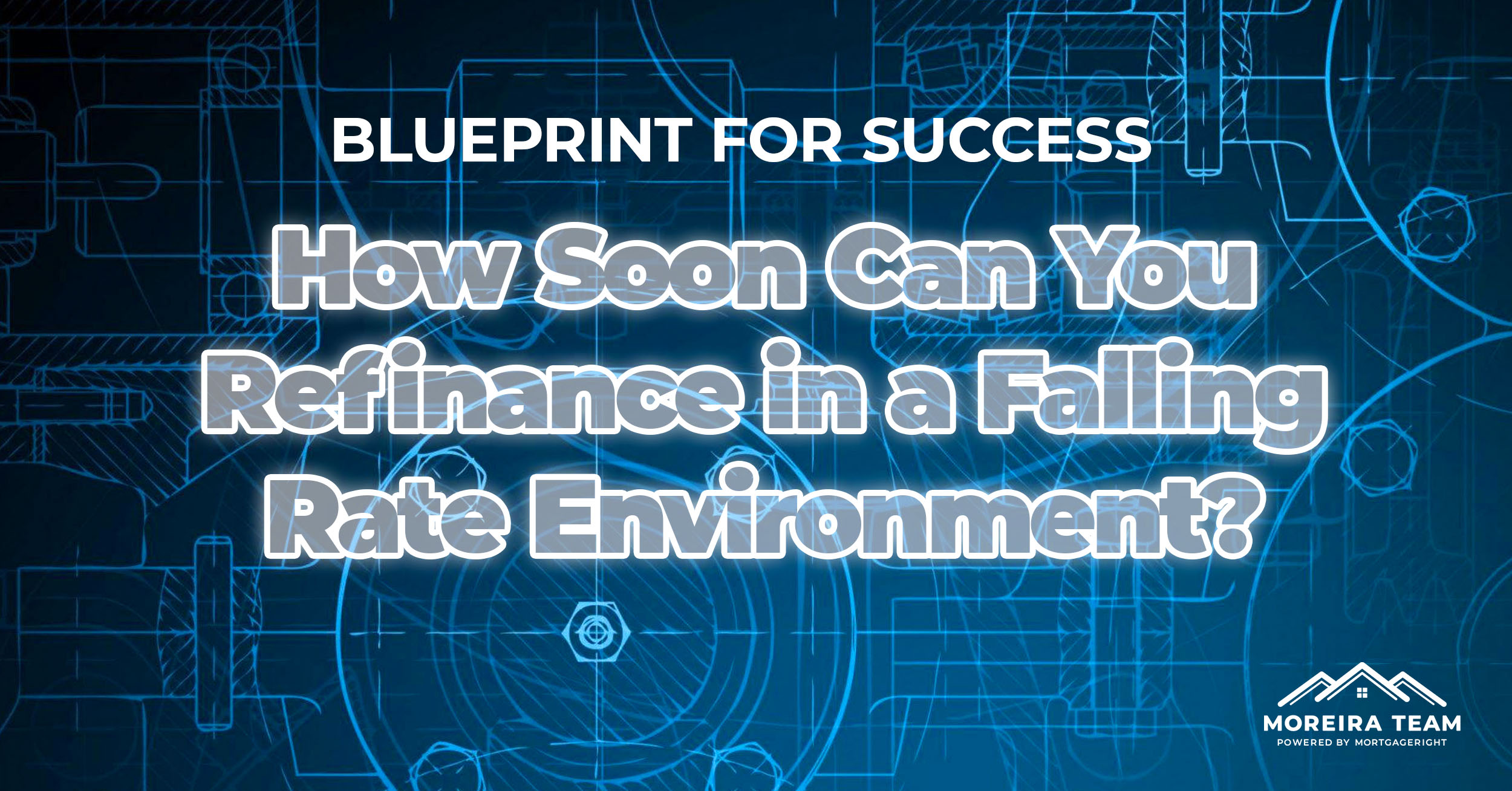
In this article
Key Takeaways:
- Take advantage of falling interest rates to reduce your payments and build long-term savings.
- Use home equity to pay off high-interest debt and improve your financial framework.
- No-cost refinancing allows you to reshape your financial structure without upfront expenses.
- Expert guidance ensures you make the best choices when designing your refinance strategy.
- Find out when you can refinance to strengthen your financial blueprint.

Preparing the Ground
Timing and planning are everything in any construction project. What is the right season? What is the right year? Where is the right location? None of these things are taken lightly, and all are carefully considered in relation to the others.
Timing your refinance is no different when you are constructing your future. The decision to lock in a lower rate should be made with the same careful consideration of both current market decisions and your long-term financial goals. In the same way a builder might factor in season, time of year, and location before starting to build, you should do the same to achieve long-term success, whether you’re a first-time homebuyer or a seasoned homeowner.
Rates are falling today, and the environment is ideal for creating the perfect blueprint for financial success. If you plan carefully and strategize, you can refinance and plan a more stable future, reduce your monthly payments, and truly capitalize on the value of your home equity.
We’re going to show you how to strategically use refinancing to architect the ideal financial blueprint and put it into action—whether you’re just beginning your journey or you’ve been a homeowner for a while. Understanding the cost to refinance mortgage rates and how to use home equity in your favor will be useful tools for anyone seeking to design their financial future.
Laying the Foundation
What’s the first thing an architect thinks about before constructing a building? Laying a strong foundation. This requires a good understanding of factors intrinsic to construction. Likewise, any homebuyer or homeowner needs to understand the foundation of the housing market—the rate environment. And in a falling rate environment, where interest rates decline gradually, homeowners have the unique opportunity to restructure their loans and potentially save thousands over the life of their mortgage.
Refinancing in a falling rate environment allows homeowners to lock in lower interest rates over time, reducing the overall cost of borrowing. Sometimes it is difficult to think about things long term, but what seems like small savings in a single month can stack up to tens of thousands or more over decades. This reduction in monthly payments frees up cash flow that you can use for other financial goals, like paying down debt, student loans, building an emergency fund, or even financial investment or investment in home improvements, ultimately increasing the value of the home.
The ability to refinance many times as rate drops can make this even better. Homeowners often wonder: How soon can you refinance a mortgage? You can often refinance as soon as six months after your last one, depending on the loan terms! Surprised? We know! This creates an opportunity to constantly improve your financial position in a falling rate environment, just as an architect would update a blueprint to bring in new materials or innovations to the overall design.
Building With Equity
Your home is not just a place to live—it’s a powerful financial asset that can be used to strengthen your overall financial situation. Over time, as you make mortgage payments, you build your equity, which is the difference between the market value of your home and the amount you owe on your mortgage. In a falling rate environment, using this equity to your advantage through refinance can be a game-changer.
Home equity, which can be converted to cash through a refinance, can be used to pay off high-interest debt, such as credit cards or personal loans, which reduces your overall financial burden. Think of it as the strength of a building’s foundation to support the weight of additional floors: the stronger the foundation, the more floors you can add. When you refinance a mortgage, you are able to consolidate debt into a single loan with a lower interest rate, thereby decreasing your monthly payments so you can use the cash for other needs.
As Al, the CEO from Moreira Team, often says, “The cliché is using good debt to pay off bad debt.” This allows you to restructure and rebuild your financial landscape, strengthens your foundation, allowing you to rise to higher heights. The difference between good debt and bad debt are the loan terms. Debt with low interest and flexible payment terms is more manageable and can often be used as wealth-building leverage. High-interest, short-term debt, on the other hand, can lead to long-term financial difficulties.
Let’s look at a real-world example. Suppose you have $15,000 in credit card debt with an interest rate of 18%—certainly not the worst-case scenario. But what if you refinanced your mortgage and used the equity in your home to pay off that debt, and you lowered your interest rate to 5% or less? This would save you potentially hundreds of dollars each month without increasing your debt burden! With this financial flexibility, you can reinvest in your future through home improvements, savings, or other ventures.
Designing the Perfect Plan
Any architect will tell you that any great building needs thoughtful design at the forefront, and the same is true for your refinance strategy. In the falling rate environment, homebuyers and homeowners have several options for restructuring their mortgages to reach maximum savings and flexibility.
1. No-Cost Refinancing
Without a doubt, it’s one of the most popular options in today’s market. With this strategy, homeowners can roll their closing costs into the loan itself, which avoids upfront expenses. This is especially popular with homeowners who want to take advantage of lower rates but may not have the cash on hand to cover closing costs.
No-cost refinancing lets you benefit from lower interest rates immediately by eliminating the need for sudden expenses. But watch out! Rolling closing costs into the loan can slightly increase the loan balance, so it’s best to weigh the long-term savings against the short-term convenience.
2. Rolling Refinances
You can also refinance multiple times in a short period. This is yet another great strategy in a falling rate environment. Known as “rolling refinances,” this allows homeowners to continually adjust their loans as rates decrease, ensuring they’re always paying the lowest possible interest rate. But how soon can you refinance a mortgage? Typically, homeowners can do it after making six monthly payments on their current loan.
This is popular in a market where rates are dropping slowly over time, since it allows you to gain additional savings without waiting for rates to reach a minimum. Think of it like an architect updating their floor plan to incorporate the latest materials and technologies, always optimizing for the best possible construction outcome.
Let’s look at an example. If you refinanced half a year ago when rates were at 6%, but now they’re at 5.5%, refinancing could save you even more money. You can ride the rate wave down and keep your financial structure as efficient as possible.
When to Break Ground: How Soon Can You Refinance a Mortgage?
We spoke about timing and its importance in construction. When you’re building your future, the same holds true for refinancing. Waiting for rates to drop even further can be risky. Don’t wait. Just as an architect knows when it’s time to break ground, homeowners should realize when market conditions are right for refinancing.
The key to this is to evaluate how much you can save over the length of the loan by solidifying that lower rate now, compared to the potential risk of rates rising in the future. The market is always in a delicate flux with millions of people trying to capitalize in a similar way, so you too must find that balance. Sometimes acting sooner is your best bet.
You should also factor in the break-even point, the moment when the savings from your lower monthly payments exceed the cost of refinancing. If you’re a homeowner planning to stay in your home for several years, refinancing can lead to major savings over time, even if the immediate savings seem small. Don’t think small. By acting at the right time, your financial blueprint will withstand the test of time.
Consulting the Experts
No architect works alone. Building something is a team effort. You can achieve a solid financial future, but you must collaborate with experts who can provide guidance and insights. Consulting with a mortgage expert is crucial in your refinancing strategy because they can tailor it to your specific needs and goals. No homeowner is exactly the same, and no financial plan is exactly the same.
A mortgage expert will help you understand all the nuances of refinancing, like balancing closing costs with long-term savings, leveraging home equity, and that nagging question in the back of everyone’s mind: How soon can you refinance a mortgage? With expert advice, you can create a detailed financial plan that addresses your unique situation and helps you make informed decisions.
In an age where financial information is plentiful but is often conflicting, scattered, or not personalized, collaborating with an expert keeping you at the forefront will ensure you get the most relevant and accurate advice. This is the cornerstone of the refinancing strategy you are building your future from, and you will avoid costly mistakes that could undermine it.
Build Your Future Now
Architecting your financial future takes careful planning and expert execution. This is no secret by now. Refinancing your mortgage in a falling rate environment provides a unique opportunity to restructure your loan, lower your monthly payments, and use your home equity to crush debt and increase cash flow.
Take the time to create a comprehensive financial blueprint. Consult with experts along the way. Don’t hesitate. You can ensure that your refinancing decisions are sound and lead to long-term financial success, and maybe one day you’ll have that bedroom with the bay window overlooking the sunset or that coveted corner office in the high-rise everyone notices on their daily commute. The choice is yours.
Ask yourself: How soon can you refinance a mortgage? If you’re ready to explore the answers, use our refinance calculator and take the first step toward building a stronger financial future today.

